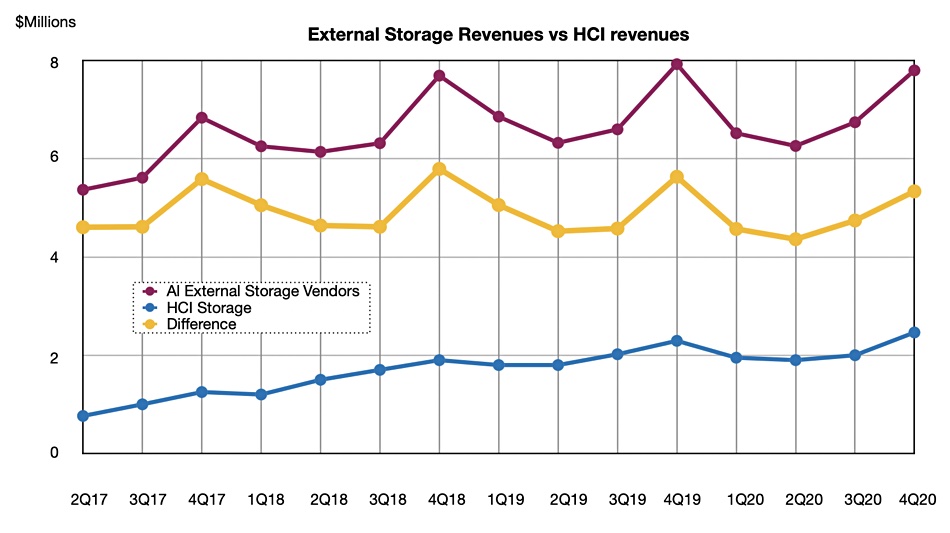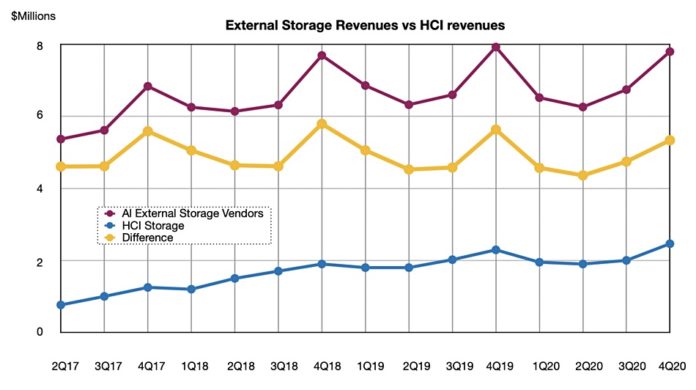Dell extended its lead over Nutanix in branded hyperconverged infrastructure (HCI) sales in the fourth 2020 quarter. Nutanix also fell back compared with VMware when measured by HCI software revenues, the latest IDC figures show.
However, Nutanix now recognises revenues over the lifetime of the contract and not at the point of sale, and this transition could mask underlying performance. Market watcher IDC notes that Nutanix’ Y/Y comparison is highly influenced by its shift away from software licenses to subscription sales, recent incentives targeting annual contract value over total contract value, and a go-to-market shift towards OEM partners.
IDC estimates the global HCI market grew 7.4 per cent in Q4. HCI is part of the overall converged systems market which IDC slices three ways in its Worldwide Quarterly Converged Systems Tracker: certified reference systems and integrated infrastructure; integrated platforms; and HCI systems. The HCI systems are tracked by the HCI brand and also by the HCI software owner to take account of OEM sales.
IDC research analyst Greg Macatee said in the press release: “The converged systems market closed out the year with tepid 0.2 per cent year-over-year growth in the fourth quarter, while the market for the full year 2020 finished down 0.6 per cent annually. That said, hyperconverged system sales were the market’s main pocket of growth in 4Q20, finishing up 7.4 per cent year over year, which is an acceleration over what we have witnessed over the past few quarters.”
- Certified reference systems and integrated infrastructure market grew revenues 0.1 per cent Y/Y to $1.6bn; 35.6 per cent of all converged systems revenue.
- Integrated platforms revenues declined 25.9 per cent Y/Y to just under $460m; 10.1 per cent of the market.
- HCI revenues grew 7.4 per cent Y/Y to $2.5 bn; 54.2 per cent of the market.
HCI numbers
Dell led the top three branded HCI sales suppliers with revenue increasing 11.1 per cent Y/Y to $801.8m revenue, giving it 32.6 per cent share – up 0.9 per cent. HPE was second, with $331.7m revs, up 25.4 per cent, and 13.5 per cent share. Nutanix was third with $254.1m revenues, down 18.8 per cent and 10.3 per cent share.
Tom Black, HPE’s SVP and GM for Storage, said in a statement: “The momentum in HPE’s HCI business continues to accelerate. This is now the second consecutive quarter in which we have clearly outperformed the market.”
Nutanix software is sold by OEMs such as Dell and HPE , and so the HCI cut by software owner presents a different revenue picture.
By this yardstick, VMware is top with $953.8m in revenues, up 1.7 per cent Y/Y, giving it 38.7 per cent share. Nutanix is in second place, with $575.5m in revenues, down 6.6 per cent Y/Y and 23.4 per cent revenue share. Unexpectedly, Huawei is in the joint third spot, with revenues of $154.5m, up 75.7 per cent, and 6.3 per cent share. It is tied with Dell Technologies, which had revenues of $137.4m, an even higher 102.4 per cent growth rate, and 5.6 per cent share.
HCI systems are taking slightly more of the overall storage market than before, as a chart indicates – if you look closely;

IDC said the external storage market (arrays, filers and object stores) declined 2.1 per cent Y/Y to $7.8 bn in revenues in the quarter. As HCI revenues were up 7.4 per cent in the same period, to $2.5bn, they gained share. The most recent three 4Q peaks in the yellow line on the chart show a gentle downward trend in the difference between HCI and external storage revenues over three years, as HCI revenues gain on external storage revenues.








